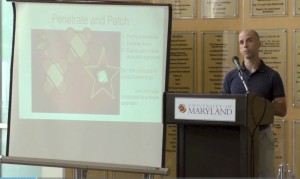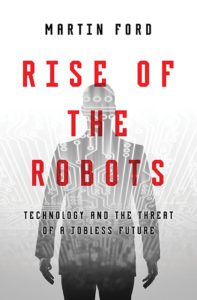This year I was pleased to be named one of U. Maryland’s Distinguished Scholar-Teachers (DSTs). This recognition, awarded to a few UMD faculty each year, is given to those who have shown success both in teaching and research. I put a lot of energy into both of these activities, so it was a great feeling to be recognized as a DST.
 One of the consequences of accepting the award is that you must give a lecture about your research/interests to a general audience. I gave my talk, titled From ‘Penetrate and Patch’ to ‘Building Security In’, on Monday.
One of the consequences of accepting the award is that you must give a lecture about your research/interests to a general audience. I gave my talk, titled From ‘Penetrate and Patch’ to ‘Building Security In’, on Monday.
My Department Chair, Samir Khuller, a DST himself, told me that I should aim the talk for an eighth grade level, i.e., an audience with only a cursory understanding of computer science. But of course it’s not quite that simple: only some people who attend will be at that level; many who attend will have a stronger background because they will be interested in the topic. So as I was preparing my talk last week I tried to make it so the generalists would not get lost, and the specialists would not get bored.
The point of my talk is that our cybersecurity woes are often (but not always) due to vulnerable software. While firewalls, anti-virus, and other security products stem the tide of attacks, these products are not addressing the root problem. Once software vulnerabilties are discovered they can be patched, but this “penetrate and patch” approach is not working: unpatched systems remain vulnerable, and even when they are the patched there are probably other latent vulnerabilities that remain. “Penetrate and patch” also doesn’t address the new vulnerabilities that are introduced as the software evolves.
So we need shift our mentality to building security in: We should aim to build software that is free of vulnerabilities (or far more likely to be free of them) right from the start.

To get this idea across to a general audience I used bridge-building as a motivation: We use the best designs, methods, and tools to build bridges that stand up to heavy use and extreme conditions. Then I talked about what software is — basically how it works — and how some software bugs can be exploited to deleterious effect. I showed, at least at a high level, how a buffer overflow works. Then I showed how language design and other PL-style research products are analogous to the best tools and methods of bridge-building, and can therefore help us avoid buffer overflows and other problems. I also described how — through my coursera software security class and the build-it, break-it, fix-it contest[ref]The next iteration of the contest starts Thursday, October 1 — not too late to sign up![/ref] — I am trying to encourage this mentality of building secure software from the start, not just leaving security to the last.
I am pretty pleased with how it turned out. Because of having to account for a broad audience, I spent a lot of time on the talk — probably as much as I did on my tenure/promotion talk! My in-laws were in attendance and they told me they understood things pretty well, and that the talk put the trajectory of recent security breaches in perspective.
A link to a video of the talk and slides is here (the proper talk starts at about the 3-minute mark):
https://www.cs.umd.edu/event/2015/09/penetrate-and-patch-building-security
The audio isn’t great, and the slides are a little hard to see (but there’s a link to the PDF), but I think it’s watchable. I’d be very curious for your feedback. I hope you will share the link with friends, tech-savvy or not, who might wonder what this cybersecurity stuff is all about, and how PL research and methods can play a important role in addressing it.





 One of the consequences of accepting the award is that you must give a lecture about your research/interests to a general audience. I gave my talk, titled From ‘Penetrate and Patch’ to ‘Building Security In’, on Monday.
One of the consequences of accepting the award is that you must give a lecture about your research/interests to a general audience. I gave my talk, titled From ‘Penetrate and Patch’ to ‘Building Security In’, on Monday.
 In this post, I interview
In this post, I interview